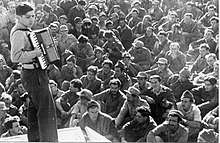Elyakum Shapirra
Elyakum Shapirra (27 December 1926 - 3 February 2014) [1] was an Israeli conductor who appeared in a number of countries. (His names also appear as Eliakum and Shapira.)
Elyakum Shapirra | |
|---|---|
| Born | 27 December 1926 |
| Died | 3 February 2014 London, England |
| Nationality | Israeli, American (naturalized) |
| Occupation | musician |
| Spouse(s) | Bernice Rubin (m 3/3/1953) |
Early life and education
He studied with Leonard Bernstein, becoming one of his assistant conductors at the New York Philharmonic.[2] He also studied with Serge Koussevitzky at Tanglewood, and at the Juilliard School.[1]
Career
He was Assistant Conductor with the San Francisco Symphony. He led the New York Philharmonic on tours to Canada and Japan in 1960-61.[1] He was guest conductor with the University of the Pacific in 1961.[3] He became Associate Conductor with the Boston Symphony Orchestra from 1962 to 1967.[1]

Robert Hall Lewis dedicated his Three Pieces for Orchestra (1966) to Shapirra and the Baltimore Symphony Orchestra.[4]
He was appointed Chief Conductor of the Malmö Symphony Orchestra in Sweden 1969-1974.[5]
Elyakum Shapirra was the first person to conduct Alexander Scriabin's Prometheus: The Poem of Fire in England with the coloured lighting that the composer called for. This occurred on 4 May 1972 at the Royal Albert Hall with the London Symphony Orchestra.[6]
Shapirra conducted the Royal Philharmonic Orchestra and soloist Georges Pludermacher in the posthumous world premiere of Jani Christou's Toccata for Piano and Orchestra (1962), on 23 April 1973 in Oxford.[7]
From 1975 to 1979 he was the Chief Conductor of the Adelaide Symphony Orchestra in Australia.[8] He was also associated with the Arnhem Philharmonic Orchestra in the Netherlands.[9]
Recordings
In 1972 Shapirra made the first commercial recording of Anton Bruckner's Symphony in F minor ("Study Symphony"), with the London Symphony Orchestra.[10] He also recorded Bruckner's Overture in G minor with the LSO.
Other symphonic recordings included Leonard Bernstein's 1st and 2nd symphonies.[11] He also recorded other standard orchestral repertoire with various orchestras, as well as Israeli, Yemeni and Yiddish songs with popular singers.[12][13]
References
- David Cummings, International Who’s Who in Music and Musicians Directory
- Time magazine, 17 October 1960, The Three Davids
- University of the Pacific
- Robert Hall Lewis Collection
- Malmö Simfoniorkester
- "Kenneth Peacock, Instruments to Perform Color-Music: Two Centuries of Technological Experimentation" (PDF). Archived from the original (PDF) on 2011-07-15. Retrieved 2009-03-29.
- Seen and Heard International
- ABC Media Release Archived 2009-09-13 at the Wayback Machine
- Igor Markevich 1912-1983
- 2001 Bruckner Marathon
- ArkivMusik
- Shoshana Damari Archived 2011-07-16 at the Wayback Machine
- My Hound